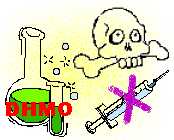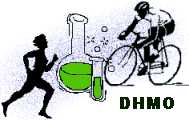Chemicals are our friends
Dihydrogen Monoxide FAQ
Dihydrogen Monoxide (DHMO) is a colorless and odorless chemical compound, also referred to by some as Dihydrogen Oxide, Hydrogen Hydroxide, Hydronium Hydroxide, or simply Hydric acid. Its basis is the unstable radical Hydroxide, the components of which are found in a number of caustic, explosive and poisonous compounds such as Sulfuric Acid, Nitroglycerine and Ethyl Alcohol.
For more detailed information, including precautions, disposal procedures and storage requirements, refer to the Material Safety Data Sheet (MSDS) for Dihydrogen Monoxide.
Should I be concerned about Dihydrogen Monoxide?
| Yes, you should be concerned about DHMO! Although the U.S. Government and the Centers for Disease Control (CDC) do not classify Dihydrogen Monoxide as a toxic or carcinogenic substance (as it does with better known chemicals such as hydrochloric acid and benzene), DHMO is a constituent of many known toxic substances, diseases and disease-causing agents, environmental hazards and can even be lethal to humans in quantities as small as a thimbleful. |  |
| Research conducted by award-winning U.S. scientist Nathan Zohner concluded that roughly 86 percent of the population supports a ban on dihydrogen monoxide. Although his results are preliminary, Zohner believes people need to pay closer attention to the information presented to them regarding Dihydrogen Monoxide. He adds that if more people knew the truth about DHMO then studies like the one he conducted would not be necessary. |
A similar study conducted by U.S. researchers Patrick K. McCluskey and Matthew Kulick also found that nearly 90 percent of the citizens participating in their study were willing to sign a petition to support an outright ban on the use of Dihydrogen Monoxide in the United States.
Why haven't I heard about Dihydrogen Monoxide before?
Good question. Historically, the dangers of DHMO, for the most part, have been considered minor and manageable. While the more significant dangers of Dihydrogen Monoxide are currently addressed by a number of agencies including FDA, FEMA and CDC, public awareness of the real and daily dangers of Dihydrogen Monoxide is lower than some think it should be.| Critics of government often cite the fact that many politicians and others in public office do not consider Dihydrogen Monoxide to be a "politically beneficial" cause to get behind, and so the public suffers from a lack of reliable information on just what DHMO is and why they should be concerned. | Part of the blame lies with the public and society at large. Many do not take the time to understand Dihydrogen Monoxide, and what it means to their lives and the lives of their families. |
Unfortunately, the dangers of DHMO have increased as world population has increased, a fact that the raw numbers and careful research both bear out. Now more than ever, it is important to be aware of just what the dangers of Dihydrogen Monoxide are and how we can all reduce the risks faced by ourselves and our families.
What are some of the dangers associated with DHMO?
Each year, Dihydrogen Monoxide is a known causative component in many thousands of deaths and is a major contributor to millions upon millions of dollars in damage to property and the environment. Some of the known perils of Dihydrogen Monoxide are:| |
|
What are some uses of Dihydrogen Monoxide?
Despite the known dangers of DHMO, it continues to be used daily by industry, government, and even in private homes across the U.S. and worldwide. Some of the well-known uses of Dihydrogen Monoxide are:
- as an industrial solvent and coolant,
- in nuclear power plants,
- by the U.S. Navy in the propulsion systems of some older vessels,
- by elite athletes to improve performance,
- in the production of Styrofoam,
- in biological and chemical weapons manufacture,
- as a spray-on fire suppressant and retardant,
- in abortion clinics,
- as a major ingredient in many home-brewed bombs,
- as a byproduct of hydrocarbon combustion in furnaces and air conditioning compressor operation,
- in cult rituals,
- by the Church of Scientology on their members and their members' families (although surprisingly, many members recently have contacted DHMO.org to vehemently deny such use),
- by both the KKK and the NAACP during rallies and marches,
- by pedophiles and pornographers (for uses we'd rather not say here),
- by the clientele at a number of homosexual bath houses in New York City and San Francisco,
- historically, in Hitler's death camps in Nazi Germany, and in prisons in Turkey, Serbia, Croatia, Libya, Iraq and Iran,
- in World War II prison camps in Japan, and in prisons in China, for various forms of torture,
- by the Serbian military as authorized by Slobodan Milosevic in their ethnic cleansing campaign,
- by many terrorist organizations,
- in community swimming pools to maintain chemical balance,
- by software engineers, including those producing DICOM software SDKs,
- in animal research laboratories, and
- in pesticide production and distribution.
| 
|
What is the link between Dihydrogen Monoxide and school violence?
 | A recent stunning revelation is that in every single instance of violence in our country's schools, including infamous shootings in high schools in Denver and Arkansas, Dihydrogen Monoxide was involved. In fact, DHMO is often very available to students of all ages within the assumed safe confines of school buildings. None of the school administrators with which we spoke could say for certain how much of the substance is in use within their very hallways. |
How does Dihydrogen Monoxide toxicity affect kidney dialysis patients?
Unfortunately, DHMO overdose is not unheard of in patients undergoing dialysis treatments for kidney failure. Dihydrogen Monoxide overdose in these patients can result in congestive heart failure, pulmonary edema and hypertension. In spite of the danger of accidental overdose and the inherent toxicity of DHMO in large quantities for this group, there is a portion of the dialysis treated population that continues to use DHMO on a regular basis.Are there groups that oppose a ban on Dihydrogen Monoxide?
| In spite of overwhelming evidence, there is one group in California that opposes a ban on Dihydrogen Monoxide. The Friends of Hydrogen Hydroxide is a group that believes that the dangers of DHMO have been exaggerated. Members claim that Dihydrogen Monoxide, or the less emotionally charged and more chemically accurate term they advocate for it, "Hydrogen Hydroxide," is beneficial, environmentally safe, benign and naturally occurring. They argue that efforts to ban DHMO are misguided. Friends of Hydrogen Hydroxide is supported by the Scorched Earth Party, a radical and loosely-organized California-based group. Sources close to the Scorched Earth Party deny any outside funding from government, industry or pro-industry PACs. |
Has the press ignored this web site and the Dihydrogen Monoxide problem?
For the most part, the press has not reported on the dangers of Dihydrogen Monoxide as much as some would like. Although many private individuals have put up web sites in a major grassroots effort to spread the word, major publications have not.Recently, attention has been paid to the subject thanks to an incident in Aliso Viejo, California. This so-called Aliso Viejo Incident was widely reported in the media, although the director of DHMO.org, Dr. Tom Way, was called a "prankster." Once the Associated Press started circulating the story, it became fact, and the valuable information being provided by the DHMO.org website was deemed to be "rubbish" rather than an honest and unbiased recounting of facts about a dangerous, life-endangering chemical compound.
If you are a member of the press, you may access our online Press Kit. See the main page for access information. This resource is for members of the press only.
Is it true that using DHMO improves athletic performance?
Absolutely! With the numerous allegations of amateur and professional athletes using anabolic steroids and/or blood doping to enhance performance, virtually no attention has been paid to the performance enhancing properties of Dihydrogen Monoxide. It is perhaps the sporting world's dirtiest of dirty little secrets that athletes regularly ingest large quantities of DHMO in an effort to gain a competitive edge over an opponent.

One technique commonly used by endurance athletes in sports such as distance running and cycling is to take a large amount of DHMO immediately prior to a race. This is known within racing circles to dramatically improve performance.
Sports-medicine physicians warn that ingesting too much Dihydrogen Monoxide can lead to complications and unwanted side-effects, but do acknowledge the link to improved performance. DHMO is not currently considered a banned substance, so post-race urine tests do not detect elevated or abnormal levels of DHMO.
Can using Dihydrogen Monoxide improve my sex life?
 | This is a popular myth, but one which is also actually supported by a number of scientific facts. Dihydrogen Monoxide plays an instrumental role in the centers of the brain associated with increased libido and orgasm. So, much as with endurance athletes, moderate intake of DHMO prior to engaging in sexual activity may enhance performance, although the same caveats apply. |
What are the symptoms of accidental Dihydrogen Monoxide overdose?
You may not always recognize that you have been a victim of accidental DHMO overdose, so here are some signs and symptoms to look for. If you suspect Dihydrogen Monoxide overdose, or if you exhibit any of these symptoms, you should consult with your physician or medical practitioner. The data presented here is provided for informational purposes only, and should in no way be construed as medical advice of any sort.  | Watch for these symptoms:
|
A recently noted medical phenomenon involves small amounts of DHMO leaking or oozing from the corners of the eyes as a direct result of causes such as foreign particulate irritation, allergic reactions including anaphylactic shock, and sometimes severe chemical depression.
What is a chemical analysis of Dihydrogen Monoxide
| Recently, German analytical chemist Christoph von Bueltzingsloewen at the Universitaet Regensburg identified what may be key reasons why the dangers of DHMO are ever present. According to von Bueltzingsloewen, the chemical separation of dihydrogenoxide from the hazardous oxygendihydride is extremely difficult. The two similar compounds curiously occur in nearly equimolar distribution wherever they are found. It is not clear how the two contribute directly to the dangers inherent in Dihydrogen Monoxide, although von Bueltzingsloewen believes that a synergetic mechanism, catalyzed by traces of hydrogenhydroxide, plays a major role. |  |
What can I do to minimize the risks?
Fortunately, there is much you can do to minimize your dangers due to Dihydrogen Monoxide exposure. First, use common sense. Whenever you are dealing with any product or food that you feel may be contaminated with DHMO, evaluate the relative danger to you and your family, and act accordingly. Keep in mind that in many instances, low-levels of Dihydrogen Monoxide contamination are not dangerous, and in fact, are virtually unavoidable. Remember, the responsibility for your safety and the safety of your family lies with you.Second, exercise caution when there is the potential for accidental inhalation or ingestion of DHMO. If you feel uncomfortable, remove yourself from a dangerous situation. Better safe than sorry.
Third, don't panic. Although the dangers of Dihydrogen Monoxide are very real, by exercising caution and common sense, you can rest assured knowing that you are doing everything possible to keep you and your family safe.
How can I find out more about Dihydrogen Monoxide?
There are a number of sites on the world wide web that contain more information on DHMO and related topics. It should be noted that we do not endorse these sites, nor do we control their content or political bias.Links to related information
DHMO web sites
- Anti-Dihydrogen
Monoxide Coalition (Ames, Iowa) - Coalition
to Ban Dihydrogen Monoxide (Headquarters) - Coalition
to Ban Dihydrogen Monoxide (Netreach) - Friends
of Hydrogen Hydroxide (DHMO supporters) - Material
Safety Data Sheet
Environmental & Safety Information
- SafetyBiz.com -
Safety Engineer Jay Preston, expert in safety services and accident
prevention - Clean Air Engineering -
promoting environmental responsibility and economic prosperity

Comments
I think you have too much time on your hands, Dave. You need to take on a project.
Michele sent me...
The ankle isn't very stable yet but I should be able to return to work tomorrow. The only reason I've stayed out is that I have to take a bus and I can't jump down from it yet. It's the only thing I'm really concerned about. Landing from that last step. Ouch!
Good job. :)
Is it safe? I use it in pastis,I hope it's all right.
Thanks for stopping by for Michele's Site of the Day!